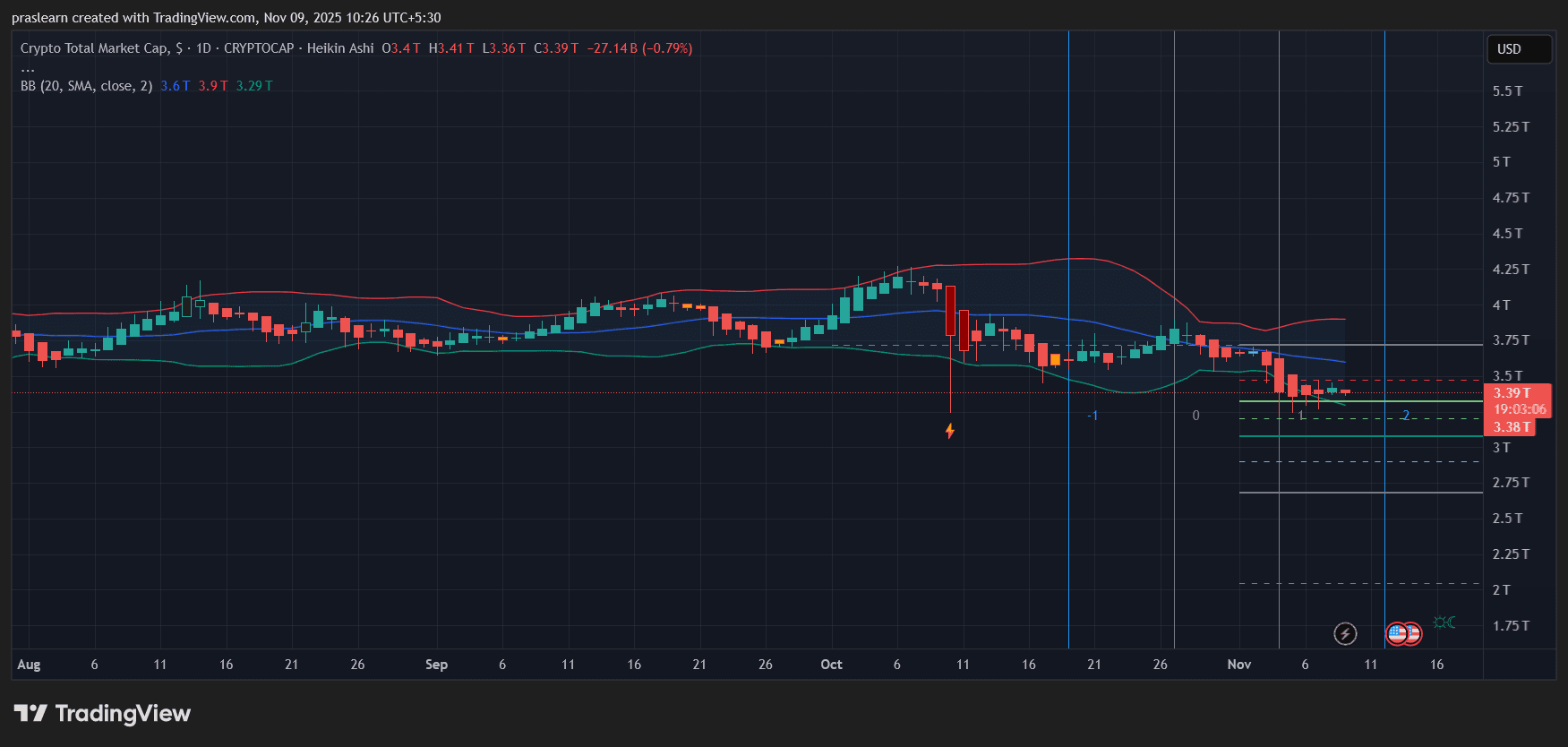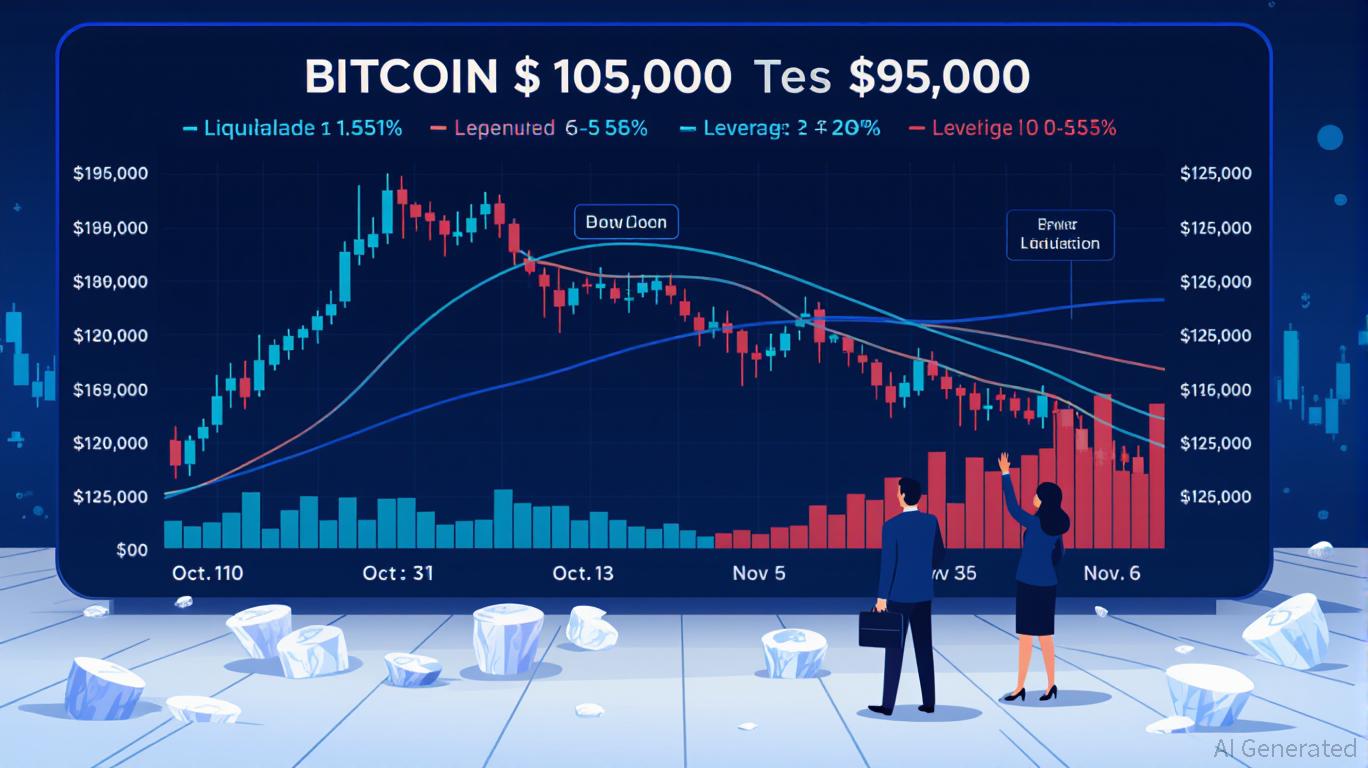Crypto News: Why Is the Crypto Market Down Today?
The global crypto market is feeling the weight of macroeconomic hesitation and institutional pullbacks, with total capitalization sliding to around $3.39 trillion. Over the last 24 hours, the market fell 1.12%, extending a week-long 7.65% decline. The selloff isn’t isolated; it mirrors a broader “risk-off” tone across global assets as investors wait for crucial economic data and trim exposure before year-end.
Why Is the Crypto Market Down Today?: Macro Uncertainty Freezes Risk Appetite
The delay of the U.S. October CPI report to November 13 has left traders without a key economic cue. With inflation data now postponed, both crypto and equities are drifting without direction. The 7-day correlation between the crypto market and Nasdaq sits at 0.69, meaning risk sentiment in tech stocks directly impacts digital assets. A strong CPI print could revive fears of prolonged high interest rates, while a weaker number may offer short-term relief.
Until then, investors are likely to stay cautious. The Cleveland Fed’s inflation nowcast remains sticky at 2.97% year-on-year, hinting that the Federal Reserve won’t pivot quickly. This uncertainty is enough to keep capital on the sidelines.
Institutional Outflows Add Pressure

Institutional sentiment has turned defensive . Bitcoin ETFs saw $558 million in net outflows in 24 hours—the largest daily withdrawal since October 10—while Ethereum ETFs recorded $46.6 million in redemptions. Total Bitcoin ETF assets under management have slipped to $138.85 billion, down nearly 2% day-over-day.

This mass pullback signals portfolio de-risking ahead of key macro events and annual rebalancing. The Fear & Greed Index has plunged to 24, marking “Extreme Fear,” its lowest level since March 2025. Institutions typically set the tone for short-term direction, and their retreat underscores that the market may not be ready for aggressive accumulation yet.
Technical Breakdown Deepens the Weakness
 Crypto Market: TradingView
Crypto Market: TradingView
On the charts, total crypto market capitalization has dropped below its 30-day simple moving average (SMA) at $3.67 trillion. The Bollinger Bands show compression after an extended decline, with the lower band sitting near $3.29 trillion—a zone that now acts as support. The RSI at 27.42 indicates an oversold market, but the MACD remains bearish, suggesting downward momentum isn’t exhausted.
From a structural view, $3.25 trillion stands out as a key support area, with potential downside wicks reaching $3 trillion if ETF outflows persist. On the upside, $3.6 trillion acts as resistance, and a daily close above this could trigger a mild recovery.
Crypto Market Down Psychology: Fear and Exhaustion
Beyond the numbers, the sentiment backdrop tells a clear story. Retail traders have reduced leveraged exposure, with open interest across exchanges dropping 11% in a day and 26% month-over-month. This signals fear-driven deleveraging rather than fundamental collapse. Historically, such conditions have preceded contrarian rebounds once selling pressure fades and liquidity stabilizes.
Still, the catalyst for a reversal is missing. Without fresh inflows or bullish macro data, the market’s best hope lies in relief rallies rather than sustained momentum.
Crypto Market: What Comes Next?
All eyes are now on the November 13 CPI release. A softer inflation number could spark renewed optimism and possibly reverse ETF flows. Conversely, a hot print could extend the decline and push total market cap toward the $3 trillion psychological level.
Traders should track ETF inflows, macro announcements, and correlation metrics with equity indices. With leverage already at yearly lows and sentiment near capitulation, a stabilization phase could emerge soon—but only if upcoming economic data aligns with cooling inflation expectations.
The crypto market isn’t crashing out of weakness—it’s retreating under macro fog, institutional caution, and technical fatigue. The setup may look grim today, but historically, such fear-dominated phases often lay the groundwork for the next big recovery wave once the data clears the air.
Disclaimer: The content of this article solely reflects the author's opinion and does not represent the platform in any capacity. This article is not intended to serve as a reference for making investment decisions.
You may also like
ICP Network Expansion: Advancing Infrastructure Integration and Enhancing Token Use in 2025
- ICP Network's 2025 upgrades (2 TiB storage, AI integration) position it as a scalable Web3 infrastructure leader. - Cross-chain breakthroughs like Bitcoin DeFi Hub and Dogecoin support expand $600B+ market access through native swaps. - Enterprise partnerships with Azure/Google Cloud and 1.2M active wallets validate infrastructure adoption amid 30% price surge. - Industrial IoT and medical TPU collaborations demonstrate real-world blockchain applications beyond DeFi. - Q3 2025 challenges include 22.4% DA

ICP Caffeine AI: A Fresh Driving Force for the Integration of Web3 and AI?
- Dfinity's Caffeine AI platform (launched 2025) enables decentralized AI app development via natural language/code/image prompts, boosting ICP's price 56% in one day. - ICP's infrastructure now supports 1.2M wallets and 237B TVL in Q3 2025, aided by Microsoft/Azure partnerships and industrial IoT solutions. - Despite 30% Q3 price surge and 261% trading volume spike, DApp engagement fell 22.4%, highlighting adoption challenges amid competition from Palantir and BigBear.ai. - Institutional interest grows vi

Bitcoin Leverage Liquidation Turmoil: Managing Market Fluctuations Through Careful Risk Strategies
- 2025 Bitcoin liquidation crisis exposed risks of 1,001x leverage as $20B+ in positions collapsed during November's $100,000 price drop. - Experts warn leveraged trading amplifies losses through panic selling cycles, with 300,000+ daily liquidations erasing $1.3B in November. - Institutional hedging strategies like JPMorgan's ETF accumulation and dynamic margin adjustments emerged as effective risk mitigation tools. - Analysts recommend avoiding extreme leverage, using stop-loss orders, and diversifying h

Bitcoin Price Fluctuations and Institutional Involvement in November 2025: Signs of Market Maturity or Continued Speculation?
- Bitcoin's November 2025 volatility (41% spike post-September) reflects maturing institutional strategies amid $20B October liquidations. - $7.8B in Q3 2025 ETF inflows and $200B institutional holdings signal Bitcoin's shift from speculative asset to treasury tool. - Hedging mechanisms (covered calls, AI trading) reduced daily volatility to 2.1%, yet macro risks persist as seen in October's crash. - Galaxy Digital's $120,000 price cut and lingering retail speculation highlight Bitcoin's dual identity as b

